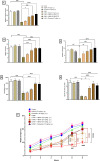18β-Glycyrrhetinic Acid Ameliorates Neuroinflammation Linked Depressive Behavior Instigated by Chronic Unpredictable Mild Stress via Triggering BDNF/TrkB Signaling Pathway in Rats
- PMID: 36307572
- PMCID: PMC9616426
- DOI: 10.1007/s11064-022-03779-7
18β-Glycyrrhetinic Acid Ameliorates Neuroinflammation Linked Depressive Behavior Instigated by Chronic Unpredictable Mild Stress via Triggering BDNF/TrkB Signaling Pathway in Rats
Abstract
Evidence shows that inflammatory responses may encompass the onset of severe depressive illness. Traditionally used licorice contains 18β-glycyrrhetinic acid (18βGA), which has been demonstrated to reduce inflammation and oxidative stress. This study investigates the antidepressant effects of 18βGA and the underlying mechanism in rats exposed to chronic unpredictable mild stress (CUMS). Wistar rats were exposed to CUMS for 36 consecutive days to establish depression. 18βGA (10, 20, and 50 mg/kg) or fluoxetine was given once daily (from day 30 to day 36). Thereafter, behavior parameters (sucrose preference test, forced-swimming test, open-field test, body weight), pro-inflammatory cytokines, neurotransmitters, adrenocorticotropic hormone (ACTH), corticosterone (CORT), and liver biomarkers were studied. Immunohistochemistry and western blot analyses were conducted to investigate the protein's expression. 18βGA (20 and 50 mg/kg) treatment increased sucrose intake, locomotion in the open-field test, decreased immobility time in the forced swim test, and improved body weight in CUMS-exposed rats. The therapy of 18βGA dramatically declined cytokines, ACTH and CORT and improved 5HT and norepinephrine in CUMS rats. Furthermore, BDNF and TrkB proteins were down-regulated in CUMS group, which was increased to varying degrees by 18βGA at doses of 20 and 50 mg/kg. Therefore, 18βGA ameliorates depressive-like behavior persuaded by chronic unpredictable mild stress, decreases neuroinflammation, liver biomarkers, stress hormones, and improves body weight, brain neurotransmitter concentration via activating on BDNF/TrkB signaling pathway in both PFC and hippocampus in rats.
Keywords: 18β-Glycyrrhetinic acid; Brain-derived neurotrophic factor; Chronic unpredictable mild stress; Depression; Tropomyosin receptor kinase B.
© 2022. The Author(s), under exclusive licence to Springer Science+Business Media, LLC, part of Springer Nature.
Conflict of interest statement
The authors state that there is no conflict of interest.
Figures








Similar articles
-
Peganum harmala L. seed extract attenuates anxiety and depression in rats by reducing neuroinflammation and restoring the BDNF/TrkB signaling pathway and monoamines after exposure to chronic unpredictable mild stress.Metab Brain Dis. 2024 Dec;39(8):1523-1541. doi: 10.1007/s11011-024-01416-6. Epub 2024 Aug 22. Metab Brain Dis. 2024. PMID: 39172328
-
Areca catechu L. ameliorates chronic unpredictable mild stress-induced depression behavior in rats by the promotion of the BDNF signaling pathway.Biomed Pharmacother. 2023 Aug;164:114459. doi: 10.1016/j.biopha.2023.114459. Epub 2023 May 26. Biomed Pharmacother. 2023. PMID: 37245336
-
Escin ameliorates CUMS-induced depressive-like behavior via BDNF/TrkB/CREB and TLR4/MyD88/NF-κB signaling pathways in rats.Eur J Pharmacol. 2024 Dec 5;984:177063. doi: 10.1016/j.ejphar.2024.177063. Epub 2024 Oct 18. Eur J Pharmacol. 2024. PMID: 39426465
-
The chronic unpredictable mild stress (CUMS) Paradigm: Bridging the gap in depression research from bench to bedside.Brain Res. 2024 Nov 15;1843:149123. doi: 10.1016/j.brainres.2024.149123. Epub 2024 Jul 16. Brain Res. 2024. PMID: 39025397 Review.
-
Pharmacological Features of 18β-Glycyrrhetinic Acid: A Pentacyclic Triterpenoid of Therapeutic Potential.Plants (Basel). 2023 Mar 1;12(5):1086. doi: 10.3390/plants12051086. Plants (Basel). 2023. PMID: 36903944 Free PMC article. Review.
Cited by
-
Peganum harmala L. seed extract attenuates anxiety and depression in rats by reducing neuroinflammation and restoring the BDNF/TrkB signaling pathway and monoamines after exposure to chronic unpredictable mild stress.Metab Brain Dis. 2024 Dec;39(8):1523-1541. doi: 10.1007/s11011-024-01416-6. Epub 2024 Aug 22. Metab Brain Dis. 2024. PMID: 39172328
-
Preventive Roles of Rice-koji Extracts and Ergothioneine on Anxiety- and Pain-like Responses under Psychophysical Stress Conditions in Male Mice.Nutrients. 2023 Sep 14;15(18):3989. doi: 10.3390/nu15183989. Nutrients. 2023. PMID: 37764773 Free PMC article.
-
Inflammation as a shared mechanism of chronic stress related disorders with potential novel therapeutic targets.Naunyn Schmiedebergs Arch Pharmacol. 2024 Nov;397(11):8383-8394. doi: 10.1007/s00210-024-03205-5. Epub 2024 Jun 8. Naunyn Schmiedebergs Arch Pharmacol. 2024. PMID: 38850304 Review.
-
A review of typical biological activities of glycyrrhetinic acid and its derivatives.RSC Adv. 2024 Feb 22;14(10):6557-6597. doi: 10.1039/d3ra08025k. eCollection 2024 Feb 21. RSC Adv. 2024. PMID: 38390501 Free PMC article. Review.
-
Role of BDNF-TrkB signaling in the antidepressant-like actions of loganin, the main active compound of Corni Fructus.CNS Neurosci Ther. 2023 Dec;29(12):3842-3853. doi: 10.1111/cns.14305. Epub 2023 Jul 5. CNS Neurosci Ther. 2023. PMID: 37408379 Free PMC article.
References
MeSH terms
Substances
Grants and funding
LinkOut - more resources
Full Text Sources
Medical
Miscellaneous

